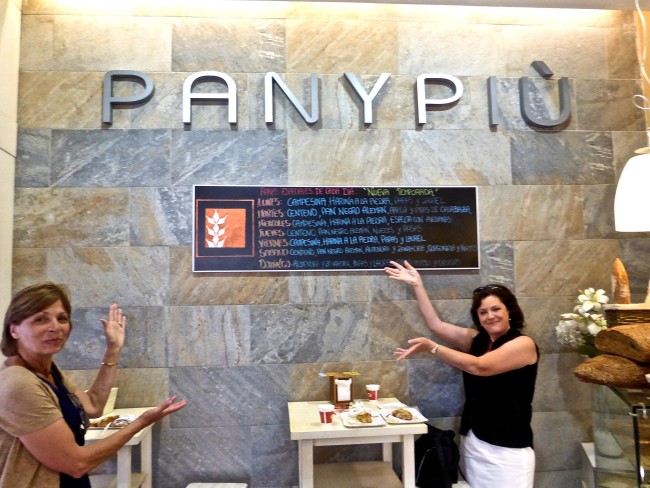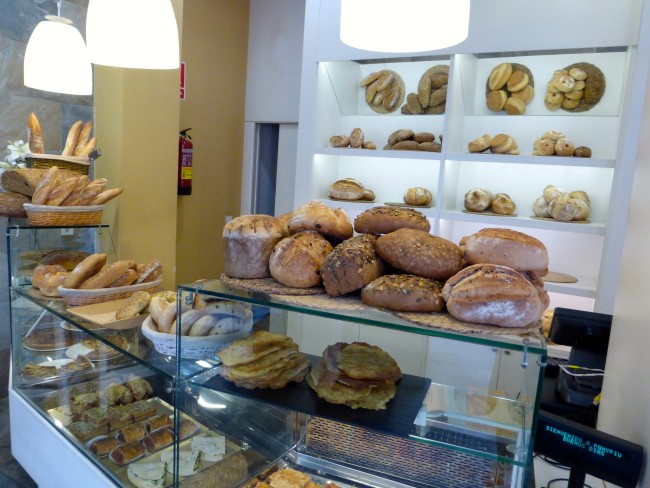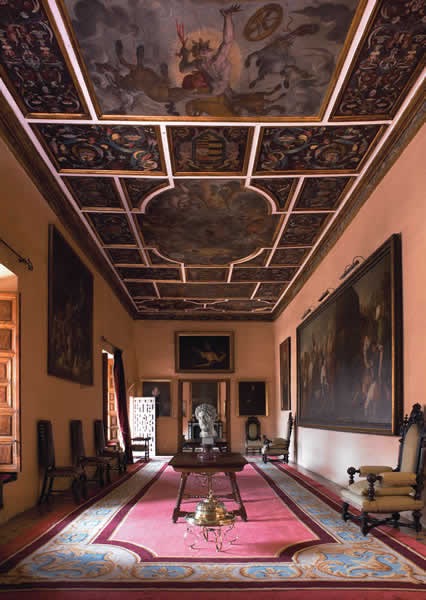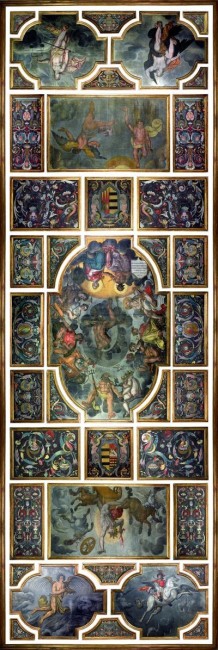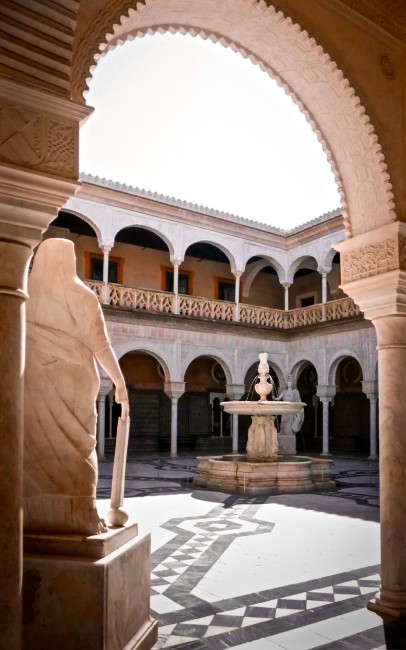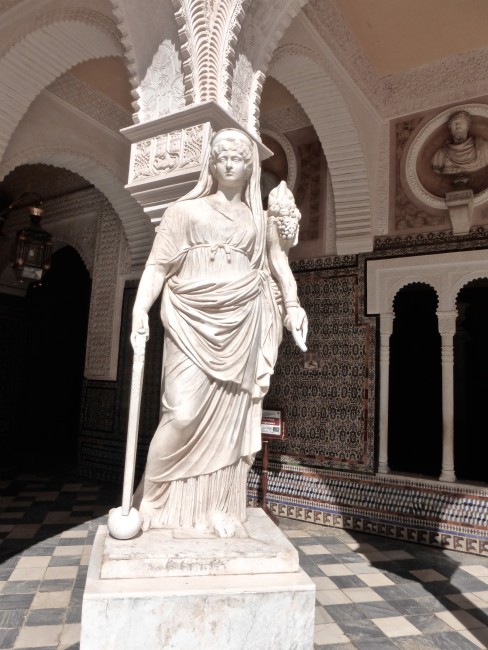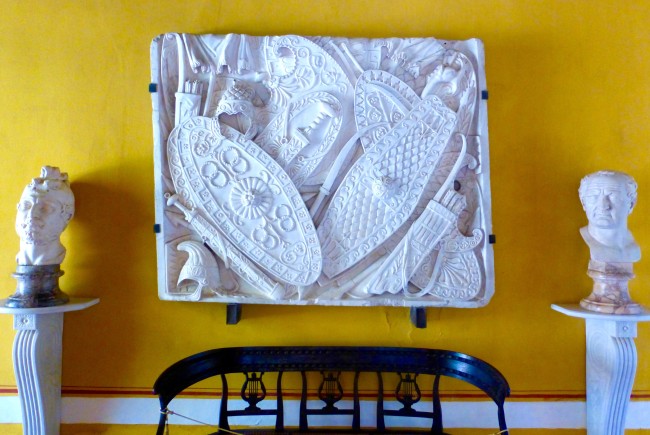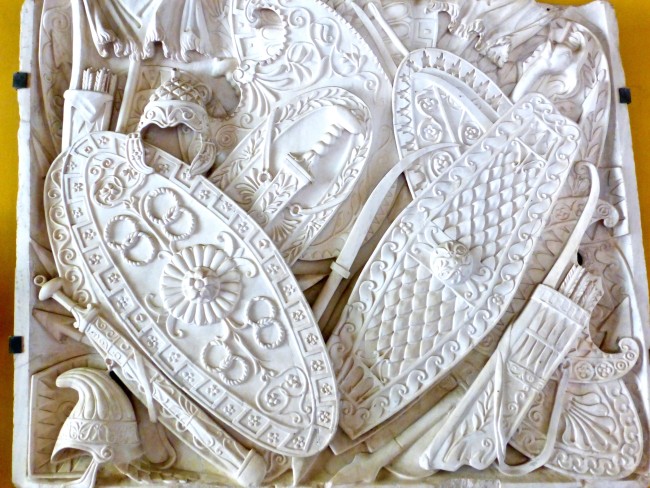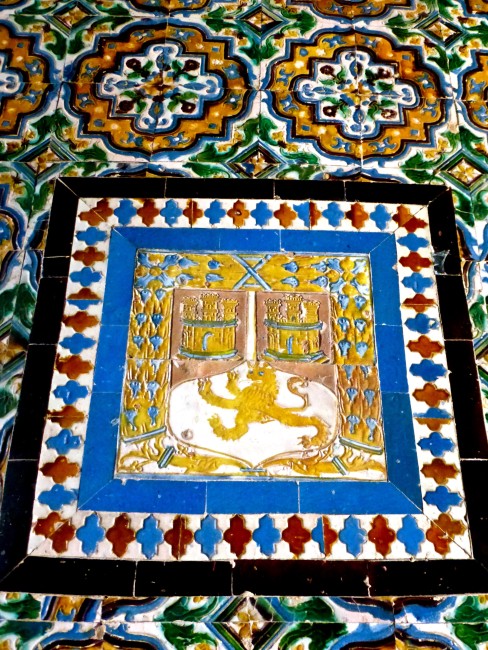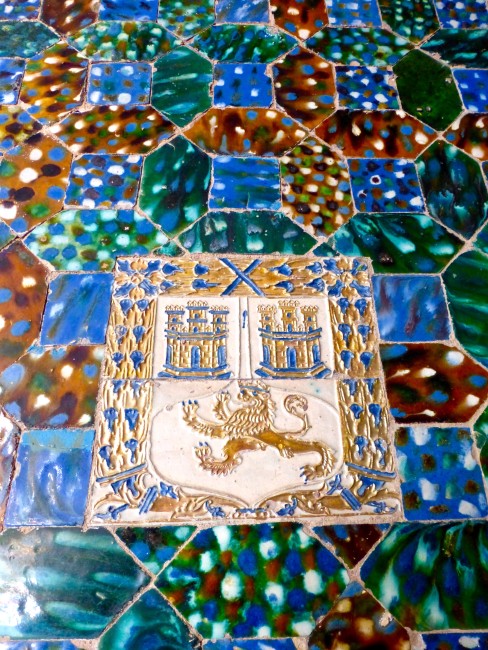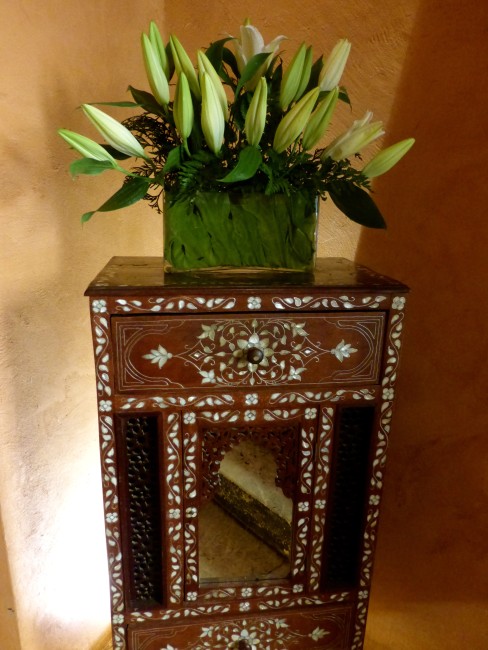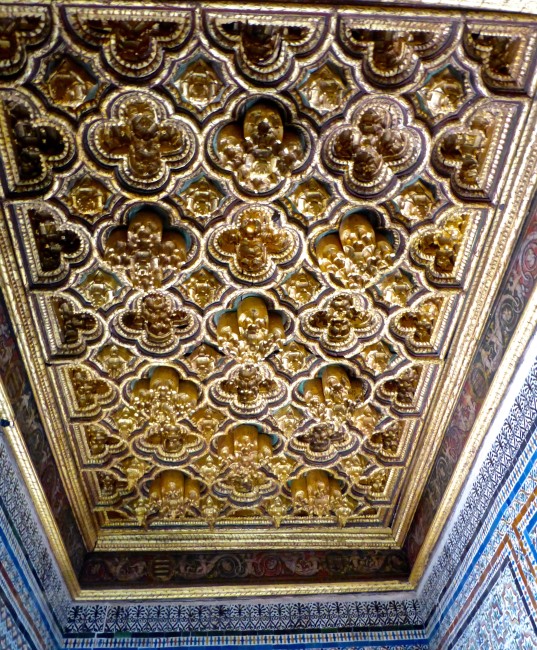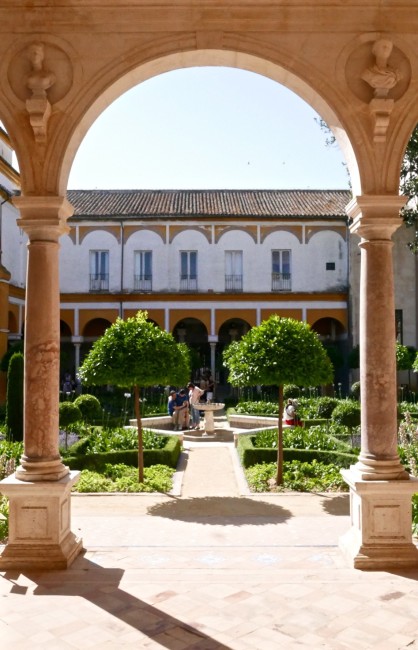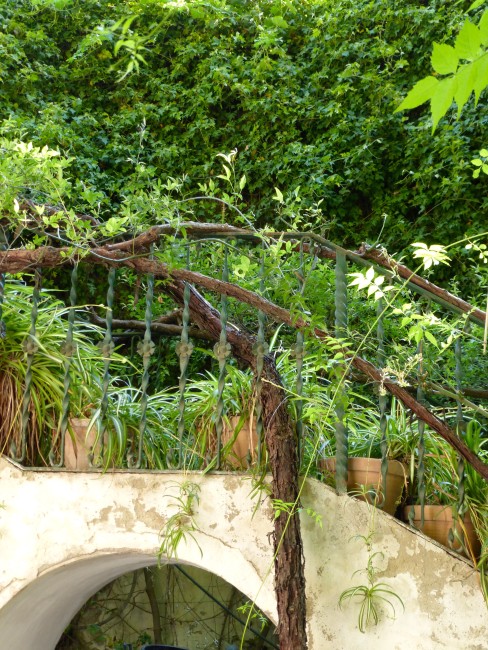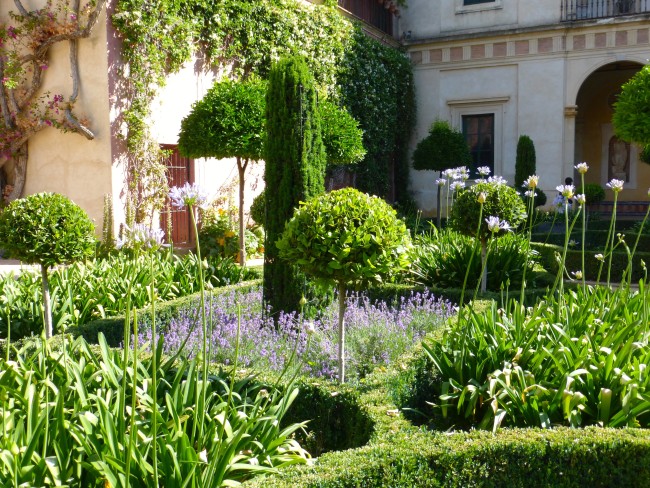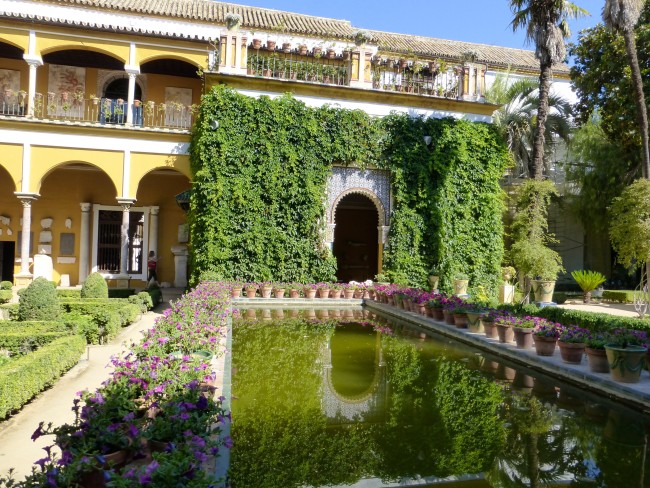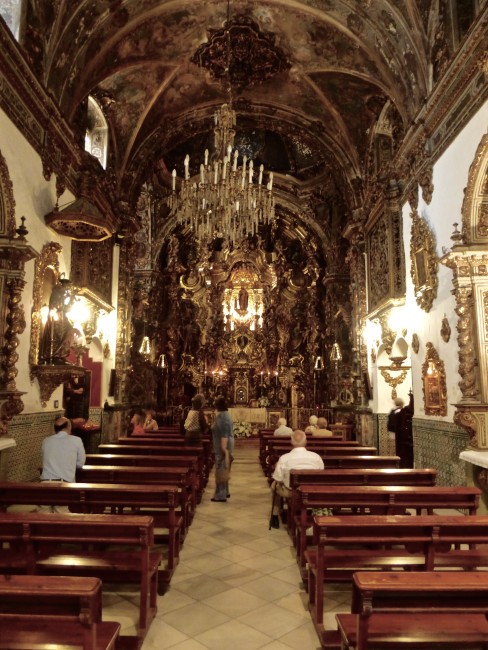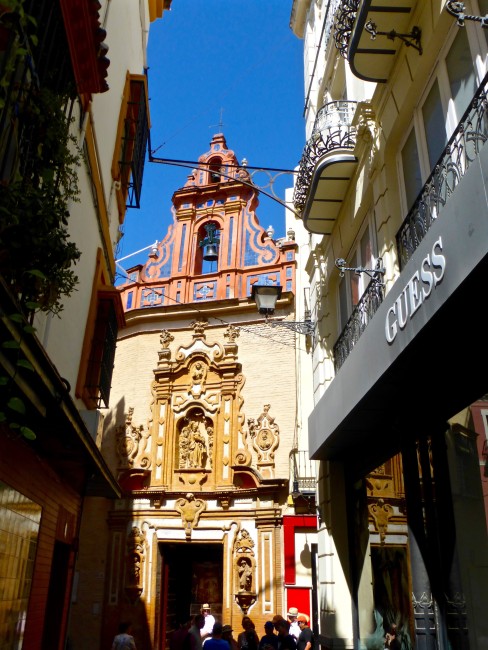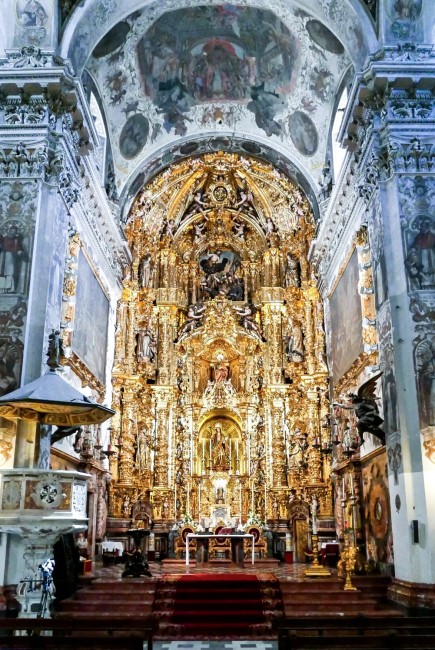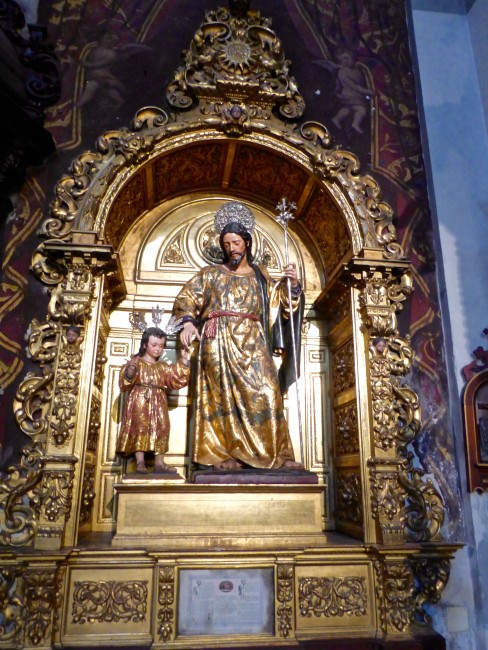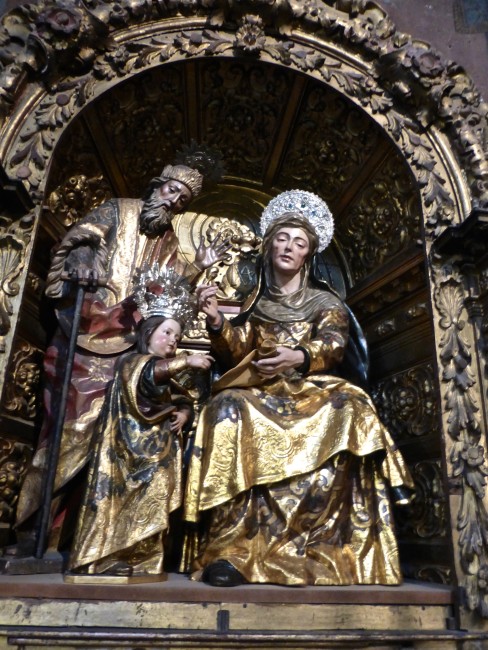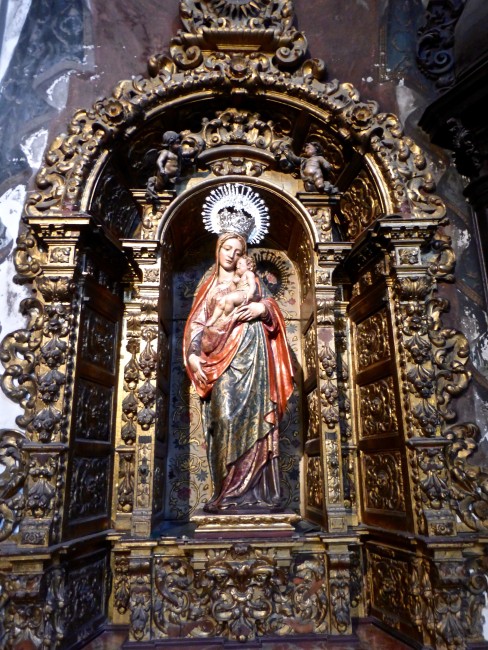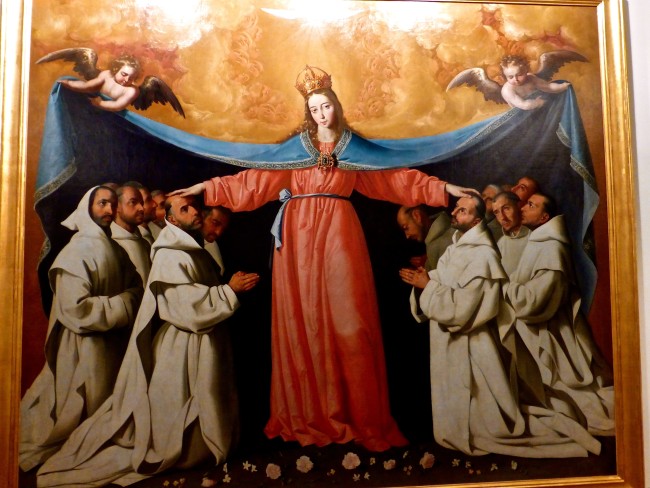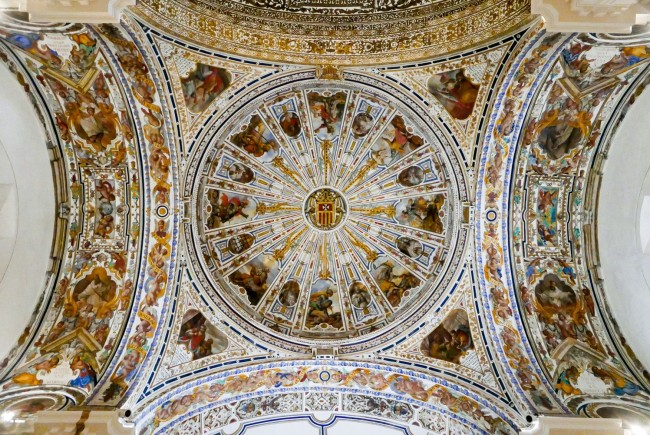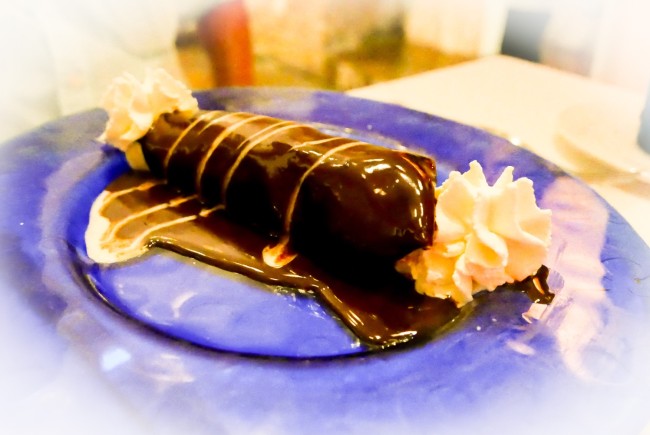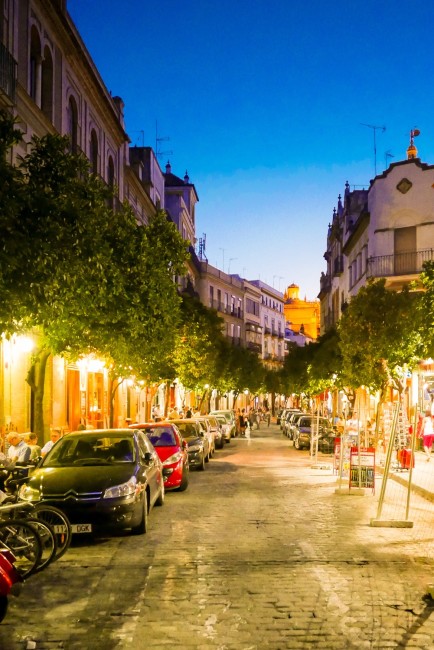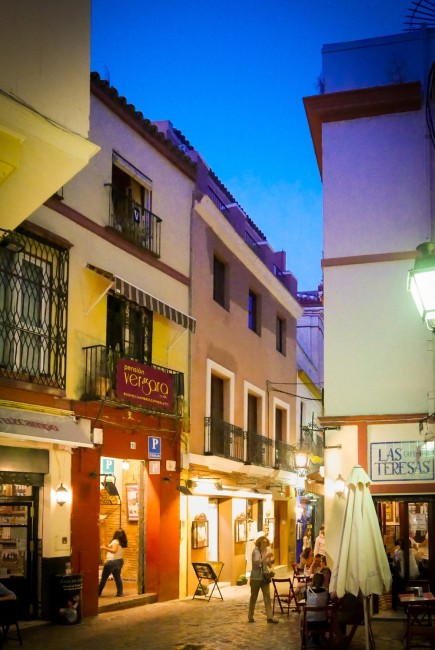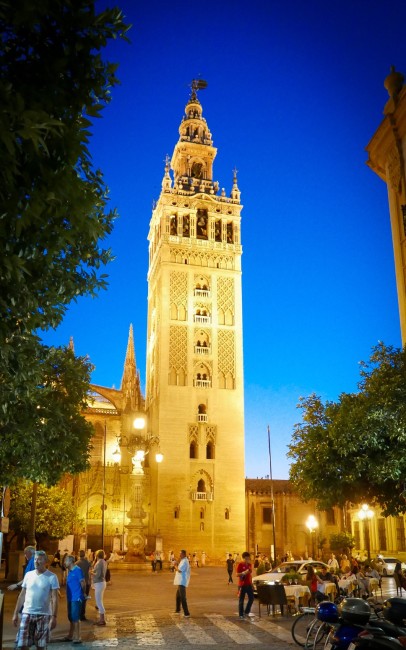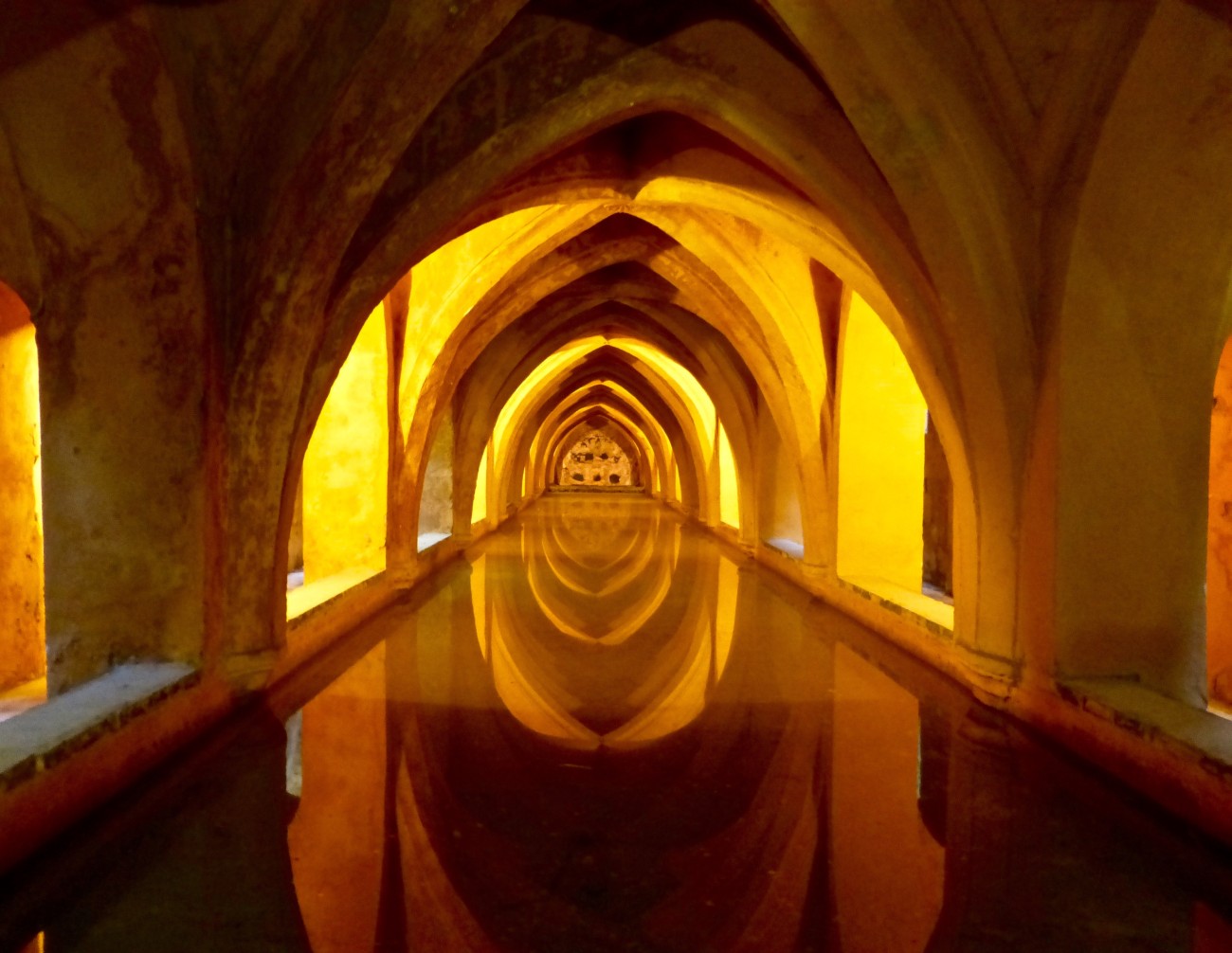
Chapter Eleven: The Alcázar & Walk Till We Drop
September 4, 2015
Chapter Thirteen: The Marvelous Mezquita
September 16, 2015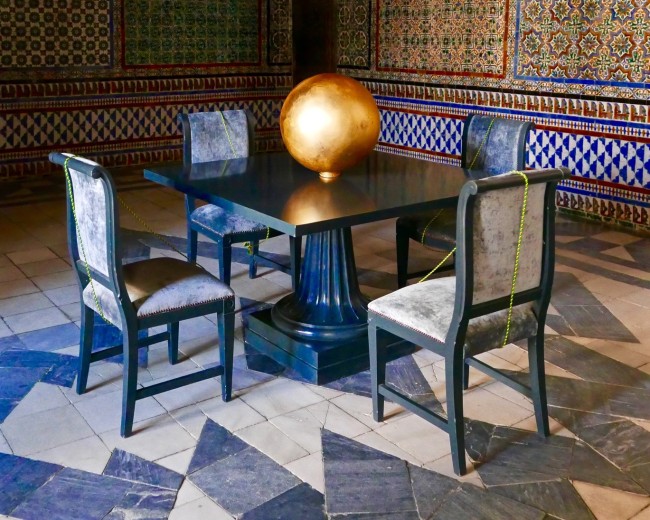 Chapter Twelve: A Hot Time In Steamy Sevilla
Chapter Twelve: A Hot Time In Steamy Sevilla
Day Twelve: Don’t Pan Pan, Pilatos Not Pilates, Do You Know The Way To San Jose, One More Church, Bellas Fellas, Losing My Head, We Finally Get To Try This Restaurant, I Will Not Be Doing The Macarena, Archeological Dining And Where’s Tom Cruise And Madonna
For some reason everyone was up fairly early (perhaps one of us was making extra noise to help roust the crew). By 9:15 we had found Pan y Più (Calle Cabeza del Rey Don Pedro, 15), a delicious bakery near our apartment.
Fortified by savory and sweet pastries and bread that didn’t cost a lot of dough…
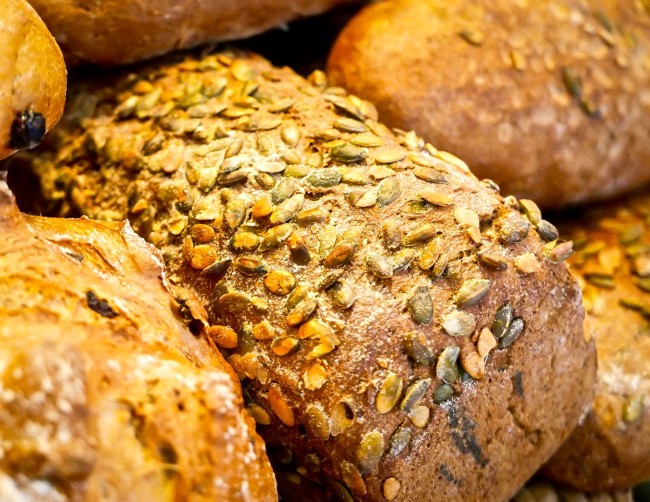 …we headed to our first stop of the morning…Casa de Pilatos. This palace dates all the way back from the late 15th century (it was home of the founders of the Enriquez de Ribera dynasty), and members of the Medinaceli family call it home today. Admission was €8.50, which included a guided tour of the upper floors and an audio tour of the lower floor and sumptuous gardens. The staircase to the upper floor has beautiful tile. It’s called “Sevilla’s first and most magnificent staircase.”
…we headed to our first stop of the morning…Casa de Pilatos. This palace dates all the way back from the late 15th century (it was home of the founders of the Enriquez de Ribera dynasty), and members of the Medinaceli family call it home today. Admission was €8.50, which included a guided tour of the upper floors and an audio tour of the lower floor and sumptuous gardens. The staircase to the upper floor has beautiful tile. It’s called “Sevilla’s first and most magnificent staircase.”
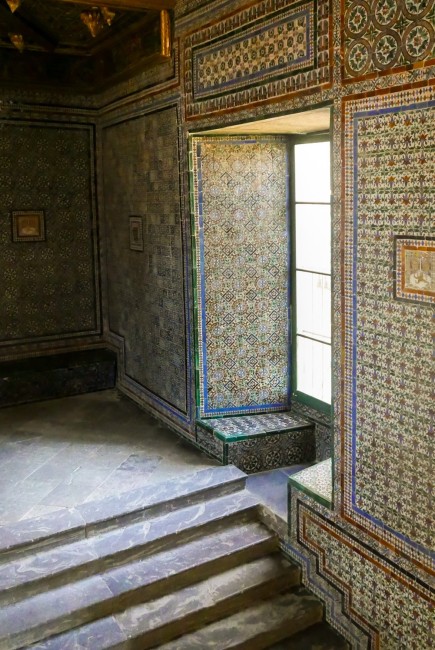 Upstairs, we toured the rooms (no photography allowed upstairs) and learned some history of the family.
Upstairs, we toured the rooms (no photography allowed upstairs) and learned some history of the family.
The rooms were beautiful. The salon photo and the ceiling of the Pacheco room (above) are both from the internet.
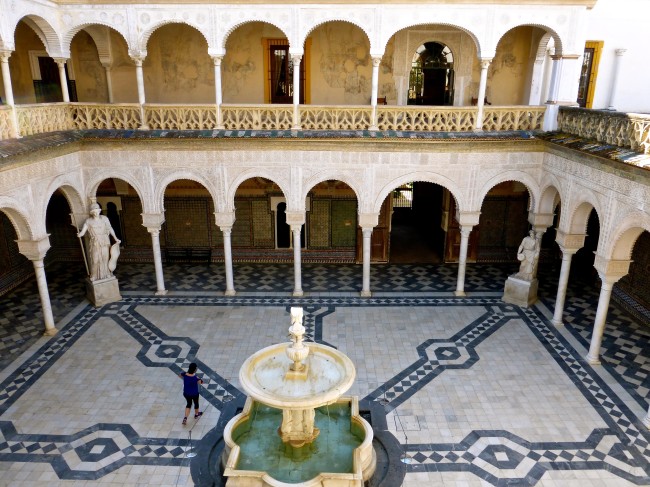 From the second floor balcony, we looked down upon the Main Courtyard designed in the Mudejar style.
From the second floor balcony, we looked down upon the Main Courtyard designed in the Mudejar style.
There are plenty of antique statues. One, from the 1500s, depicts Marcus Aurelius’ wife Faustina Minor (I guess you could marry a Minor back then).
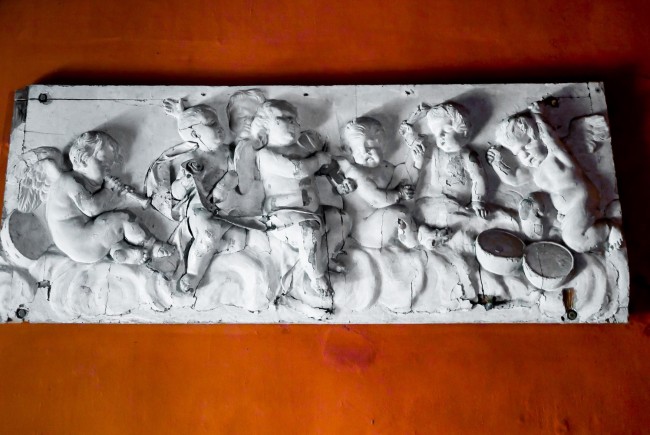 Antiquities were the order of the day…
Antiquities were the order of the day…
…in the downstairs rooms, too.
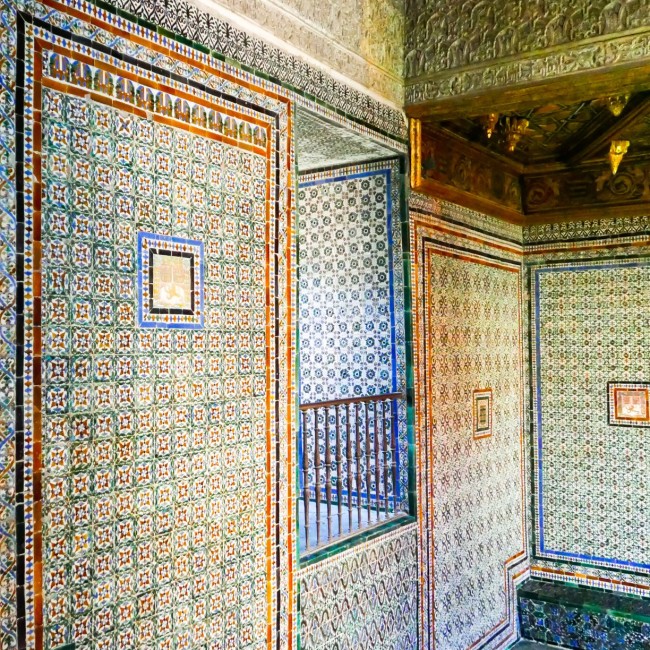 I believe the above photo from Kim is from the Praetor’s Room, the largest and most beautiful of all the rooms downstairs. This room is named for Pilate’s Palace in Jerusalem.
I believe the above photo from Kim is from the Praetor’s Room, the largest and most beautiful of all the rooms downstairs. This room is named for Pilate’s Palace in Jerusalem.
The mosaics throughout the house were stunning.
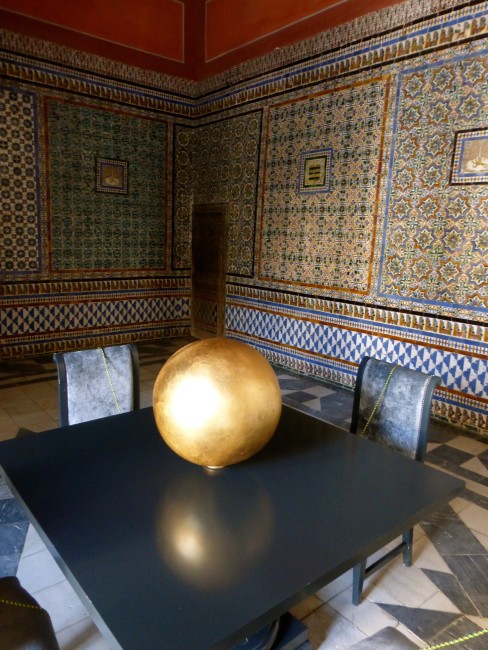
The Salón de Descanso de los Jueces (The Judges’ Resting Room) had a table with a giant gold bowling ball (without the holes) resting on it.
We caught a glimpse of the striking ceiling in a ceremonial space known as Pilate’s Cabinet. The time spent in the Flagellation Chapel…
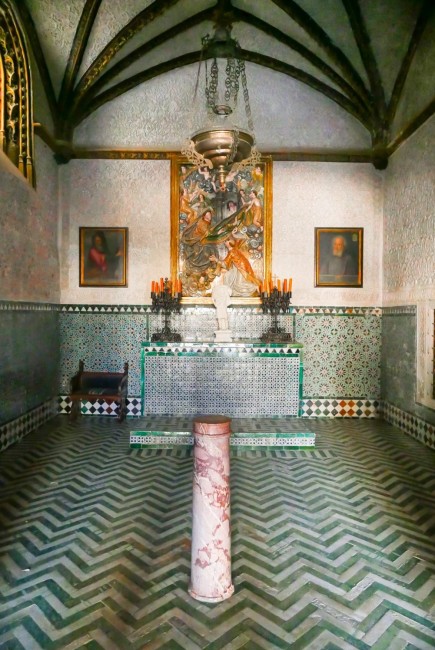 …was cut short because we were already whipped from the heat…
…was cut short because we were already whipped from the heat…
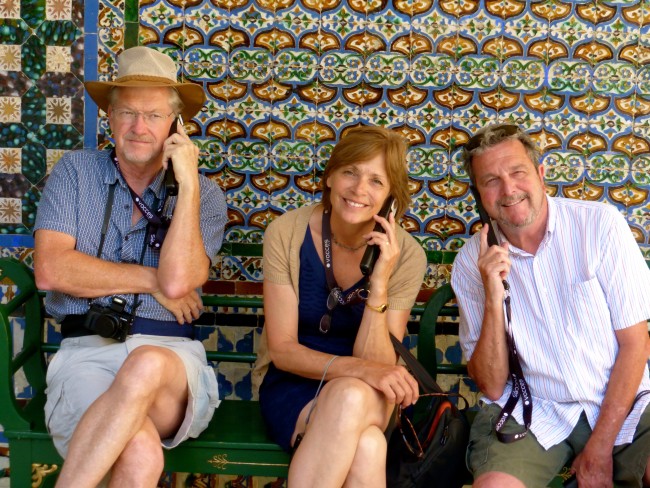 …so much so, we took a brief respite before seeing the gardens.
…so much so, we took a brief respite before seeing the gardens.
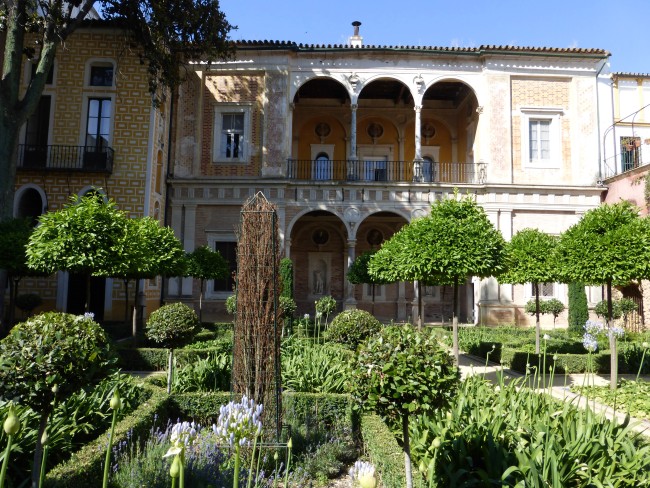 Outside are two gardens. The Large Garden (The Palace of the Duke of Alcala) was once used as an orchard…
Outside are two gardens. The Large Garden (The Palace of the Duke of Alcala) was once used as an orchard…
…and the “Small Garden,”…
that’s really not that small.
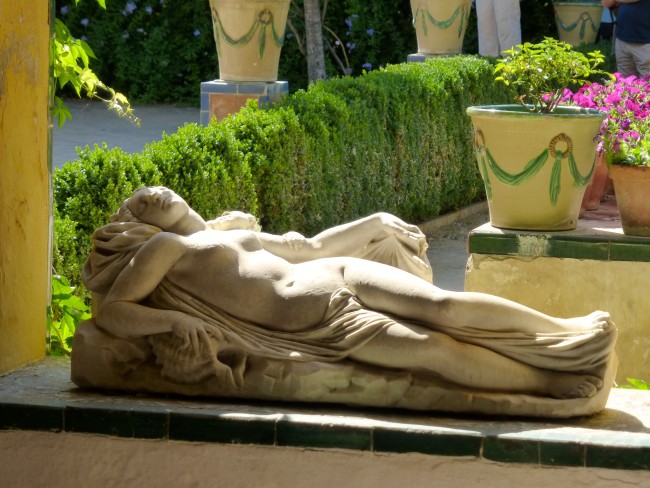 It was time to move on. Our next destination, the 18th century Iglesia de San José, had caught my interest when I was researching the trip. I asked Maapman Kim if he knew the way to San José, and he did. Burt Bacharach and Hal David couldn’t have done a better job.
It was time to move on. Our next destination, the 18th century Iglesia de San José, had caught my interest when I was researching the trip. I asked Maapman Kim if he knew the way to San José, and he did. Burt Bacharach and Hal David couldn’t have done a better job.
The church is run by the Franciscan order, who I believe live about 45 miles north of San José. The church is quite dark inside.
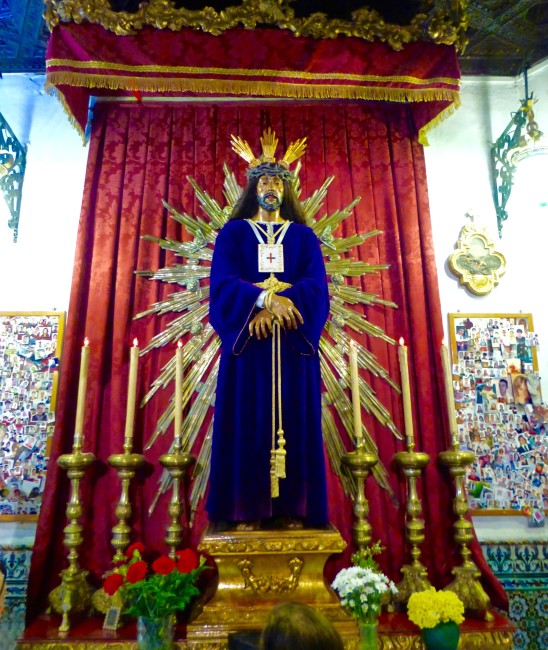 The Captive Christ of Medinaceli is one of the figures most venerated by the Sevillian parish. Below we’d see the head of St. John the Baptist, and losing our heads would become a theme a little later in the day. Being a smaller church, it was a quick visit…
The Captive Christ of Medinaceli is one of the figures most venerated by the Sevillian parish. Below we’d see the head of St. John the Baptist, and losing our heads would become a theme a little later in the day. Being a smaller church, it was a quick visit…
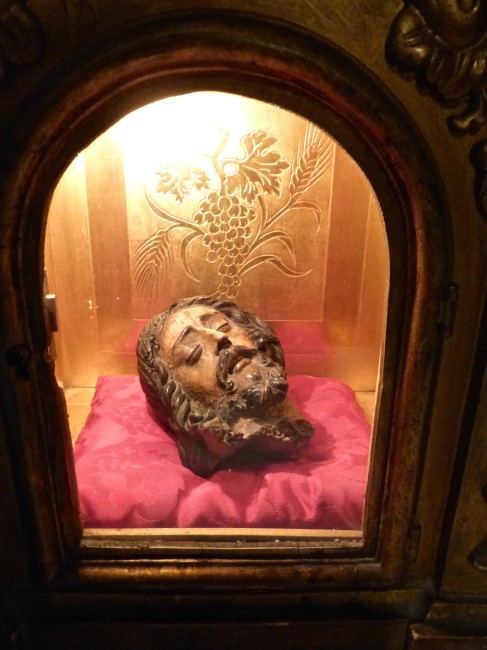 …before hitting another church, Iglesia Santa María Magdalena.
…before hitting another church, Iglesia Santa María Magdalena.
Once again…
….it was a short stop on an increasingly hot day.
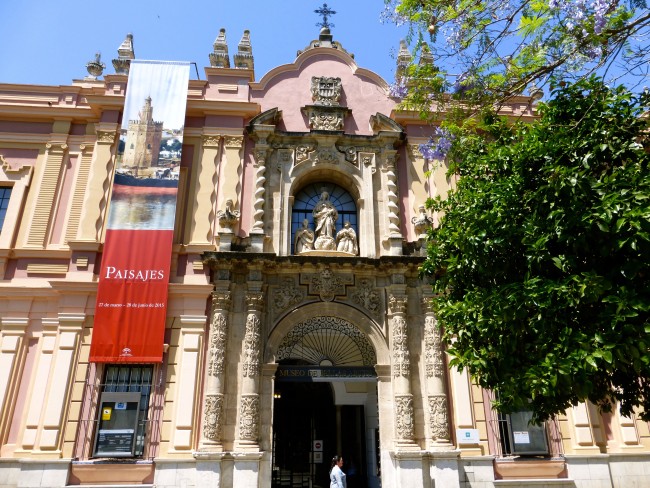 Now it was time to acquire a little culture (which is about all the culture we can handle) at the Museo de Bellas Artes, a former convent building that now houses a treasure trove of Spanish art. The convent was constructed for the Order of the Merced Calzada de la Asunción in 1594 during Sevilla’s golden age of painting and ceramics. We paid the €1.50 entrance fee (free for those with an EU passport), which included an audio guide, and walked into the gorgeous interior courtyard.
Now it was time to acquire a little culture (which is about all the culture we can handle) at the Museo de Bellas Artes, a former convent building that now houses a treasure trove of Spanish art. The convent was constructed for the Order of the Merced Calzada de la Asunción in 1594 during Sevilla’s golden age of painting and ceramics. We paid the €1.50 entrance fee (free for those with an EU passport), which included an audio guide, and walked into the gorgeous interior courtyard.
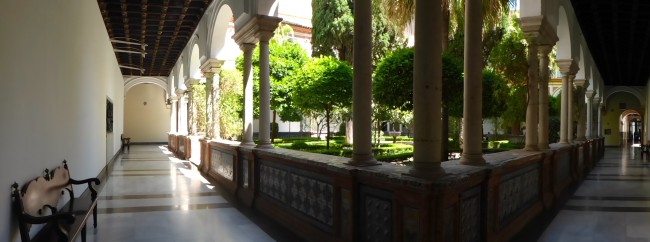 I also really liked the color of the walls of the galleries, as they made the paintings stand out that much more.
I also really liked the color of the walls of the galleries, as they made the paintings stand out that much more.
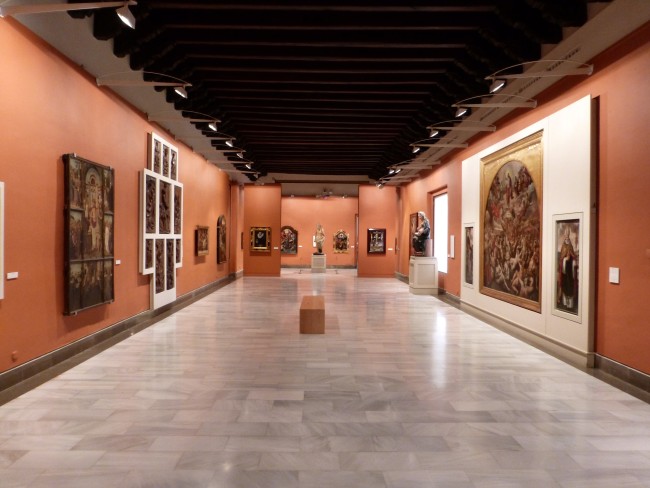 Among the works we viewed were Pietro Torrigiano’s San Jerónimo Penitente from the 16th century. Goya was a great admirer of this statue.
Among the works we viewed were Pietro Torrigiano’s San Jerónimo Penitente from the 16th century. Goya was a great admirer of this statue.
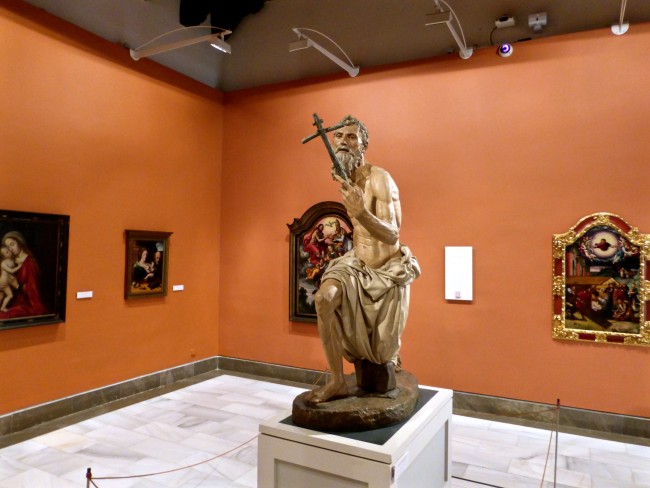 We saw the 1629 painting, Virgen de las Cuevas (Virgin of the Misericordia Sheltering the Carthusians), by Francisco de Zurbaran and his…
We saw the 1629 painting, Virgen de las Cuevas (Virgin of the Misericordia Sheltering the Carthusians), by Francisco de Zurbaran and his…
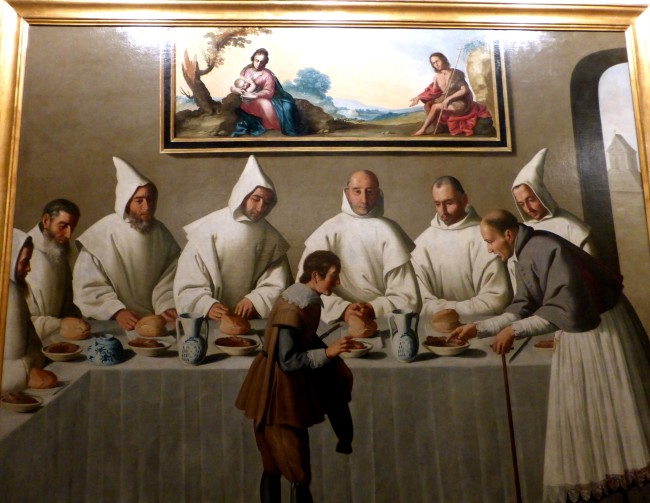 Other paintings I liked were La muerte del maestro by José Villegas (the original “The Day the Music Died”)…
Other paintings I liked were La muerte del maestro by José Villegas (the original “The Day the Music Died”)…
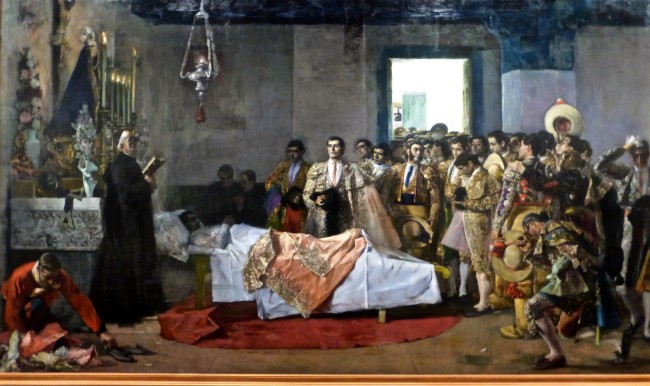 …Pieter Aertsen’s Coronación de la Virgen…
…Pieter Aertsen’s Coronación de la Virgen…
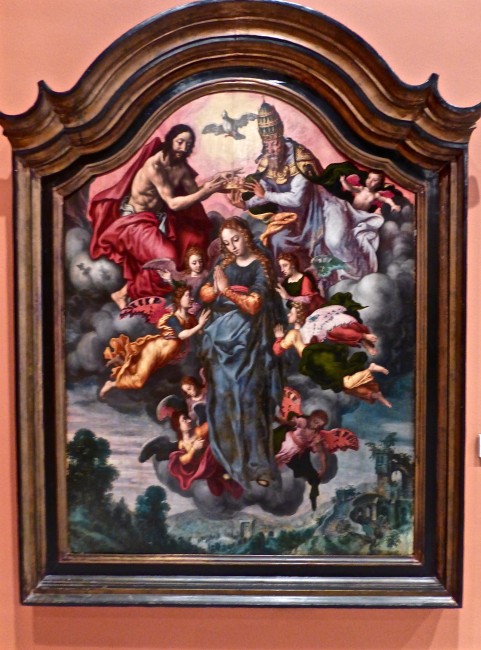 …and Domingo Martinez’s Carro del Pregon de la Mascara.
…and Domingo Martinez’s Carro del Pregon de la Mascara.
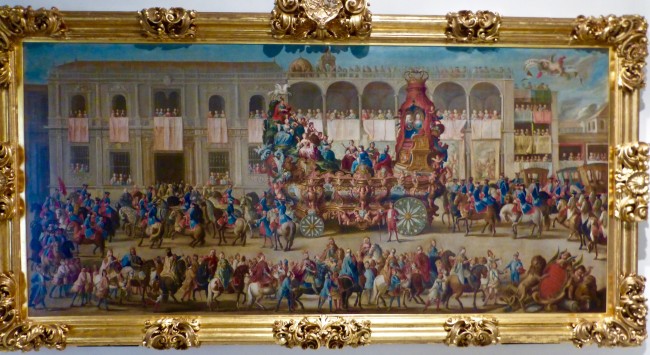 We took a look at another St. John The Baptist head (I’d join him in a few minutes).
We took a look at another St. John The Baptist head (I’d join him in a few minutes).
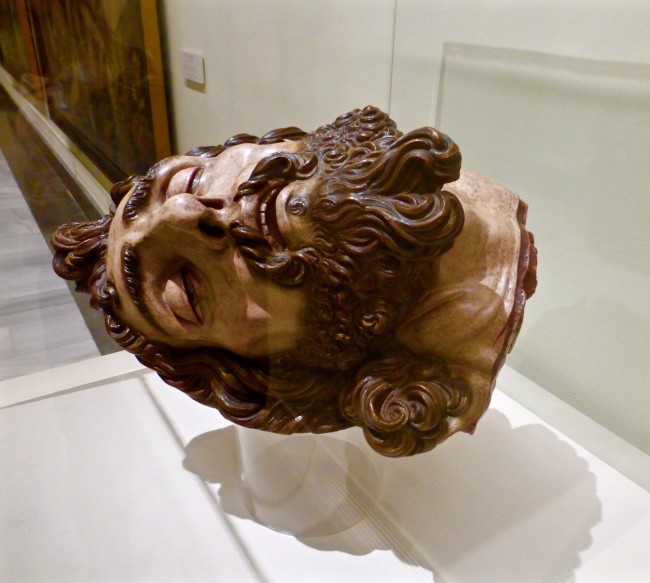 The Assention of Holy Virgin sculpture by Juan de Oviedo el Mozo also made us stop to admire it.
The Assention of Holy Virgin sculpture by Juan de Oviedo el Mozo also made us stop to admire it.
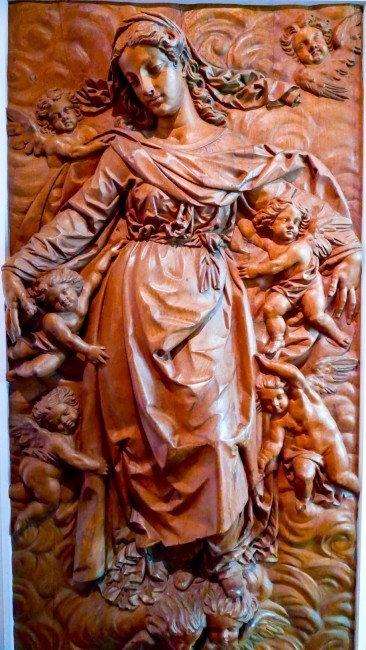 Entering the giant hall of paintings, the room…
Entering the giant hall of paintings, the room…
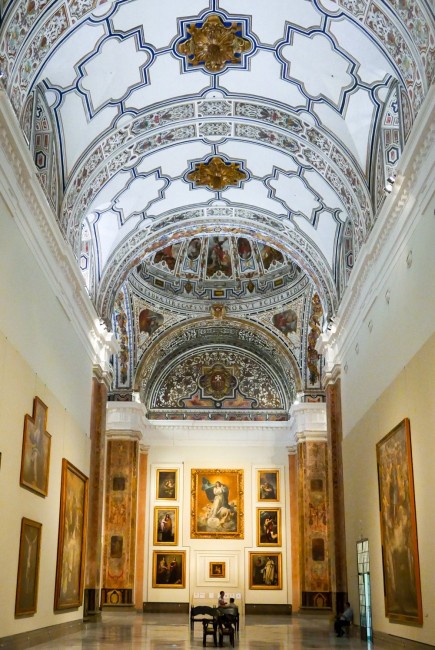 …rivaled the paintings for beauty…
…rivaled the paintings for beauty…
..as did the ceilings in this building….
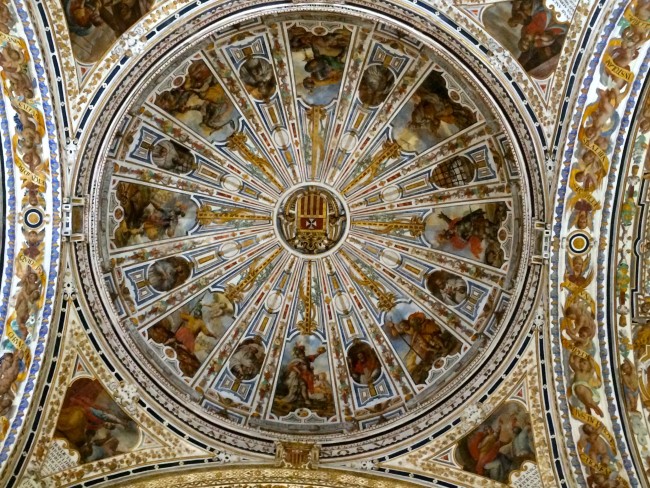 But when Tracy took a picture of me in this room on her iPhone, my head had disappeared when we looked at the photo. I could understand if this had happened in the Washington Irving room at the Alhambra, but I was going out of my head trying to figure out how that happened. After seeing the picture, I said. “Let’s beheading out of here.”
But when Tracy took a picture of me in this room on her iPhone, my head had disappeared when we looked at the photo. I could understand if this had happened in the Washington Irving room at the Alhambra, but I was going out of my head trying to figure out how that happened. After seeing the picture, I said. “Let’s beheading out of here.”
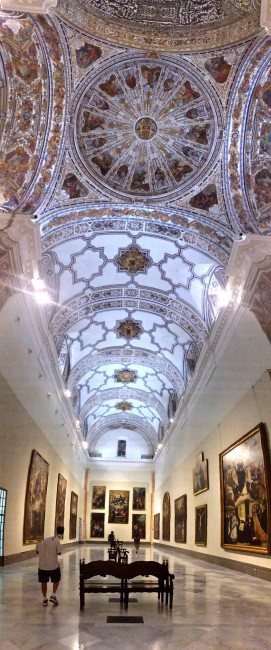 I highly recommend stopping by the Museo de Bellas Artes…but watch your head.
I highly recommend stopping by the Museo de Bellas Artes…but watch your head.
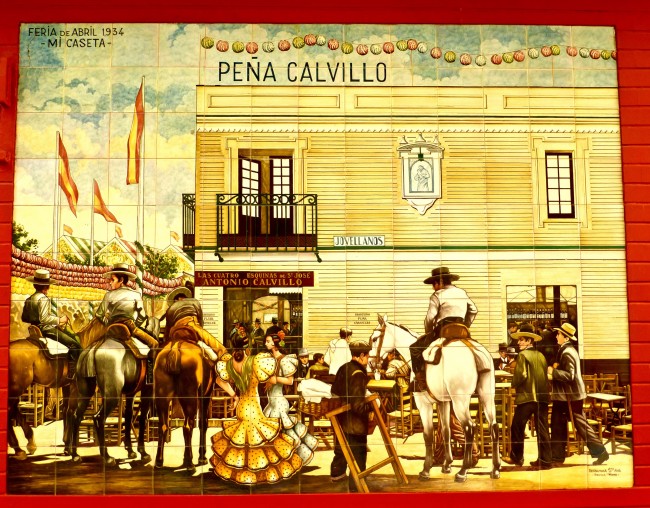 I don’t have a clue where we saw the 1934 Pena Calvillo Sevilla Horsemen Horses, but I liked it.
I don’t have a clue where we saw the 1934 Pena Calvillo Sevilla Horsemen Horses, but I liked it.
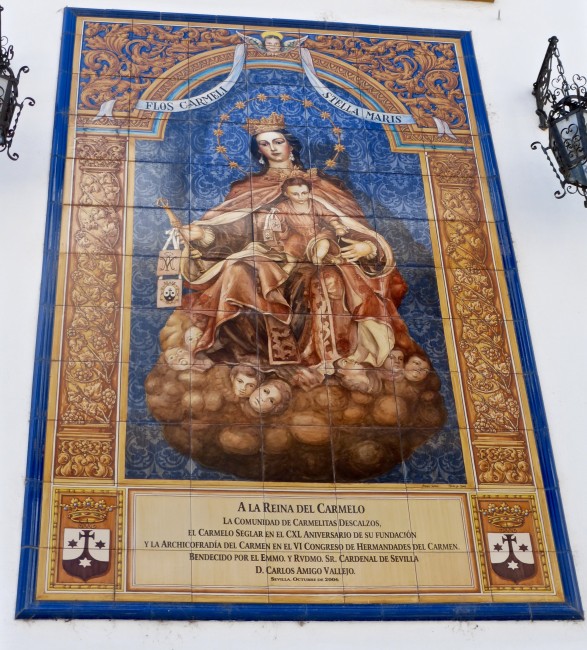 We walked by the Iglesia del Santo Ángel, which had the cool Retablo Cerámico de la Virgen del Carmen on the outside on the way back to our neighborhood for lunch.
We walked by the Iglesia del Santo Ángel, which had the cool Retablo Cerámico de la Virgen del Carmen on the outside on the way back to our neighborhood for lunch.
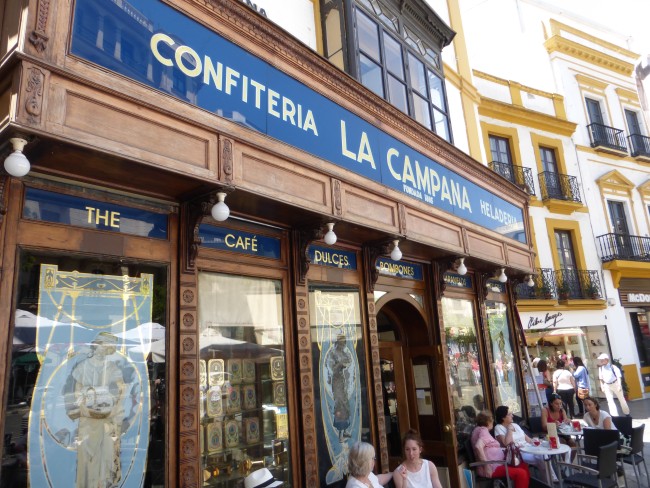 Soon, however, we were momentarily enticed into the Confiteria la Campana, a famous Sevilla bakery and café.
Soon, however, we were momentarily enticed into the Confiteria la Campana, a famous Sevilla bakery and café.
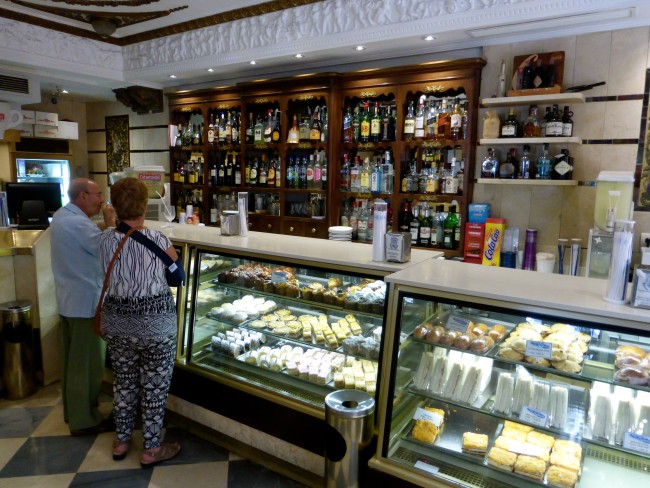 We thought about getting a yema (soft, crumbly biscuit cake wrapped like a toffee) or nata (custard cake) or perhaps a GinTonic…
We thought about getting a yema (soft, crumbly biscuit cake wrapped like a toffee) or nata (custard cake) or perhaps a GinTonic…
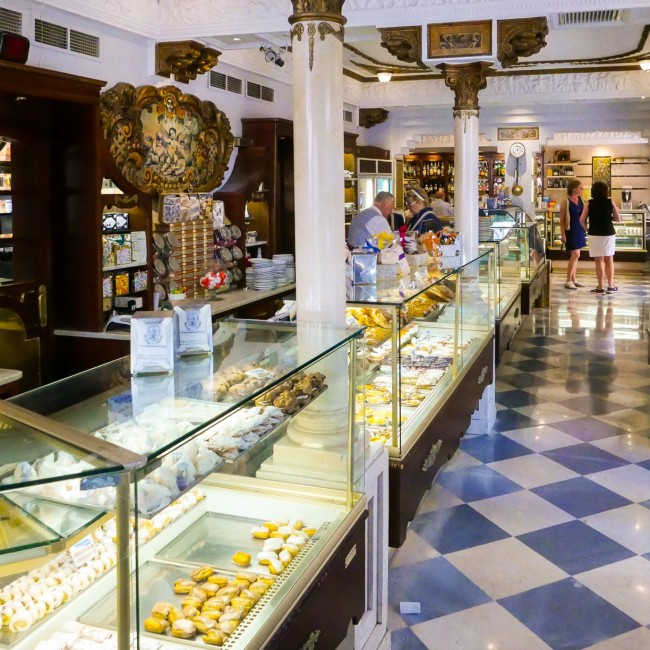 …but instead pressed on toward a neighborhood restaurant recommended by Gary (of Spain Select). It had been packed each time we had walked by on previous days.
…but instead pressed on toward a neighborhood restaurant recommended by Gary (of Spain Select). It had been packed each time we had walked by on previous days.
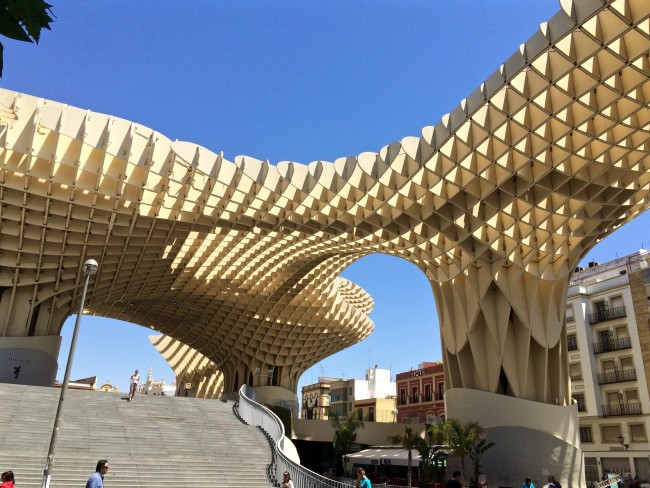 On the way, we took one last pass by the Metropol Parasol to see what it looked like in the daytime. Actually, I think we just wanted some shade.
On the way, we took one last pass by the Metropol Parasol to see what it looked like in the daytime. Actually, I think we just wanted some shade.
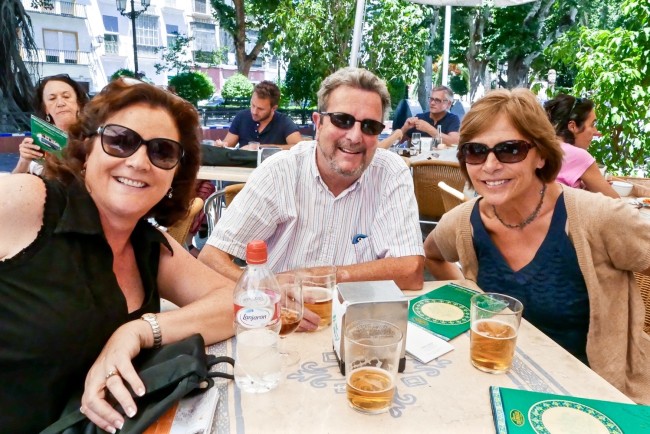 We scored the last table (there are only eight) outside at Taberna Coloiniales (Plaza del Cristo de Burgos, 19). This place had tasty food and quick service, which was good since we were now melting. Mary ordered the winning dish…a special grilled veggie dish topped with a quail egg.
We scored the last table (there are only eight) outside at Taberna Coloiniales (Plaza del Cristo de Burgos, 19). This place had tasty food and quick service, which was good since we were now melting. Mary ordered the winning dish…a special grilled veggie dish topped with a quail egg.
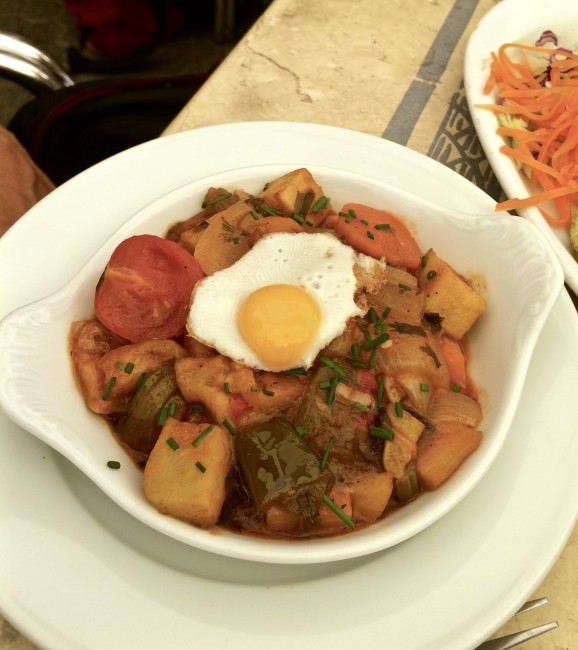 The beer tasted exceptionally good on this day.
The beer tasted exceptionally good on this day.
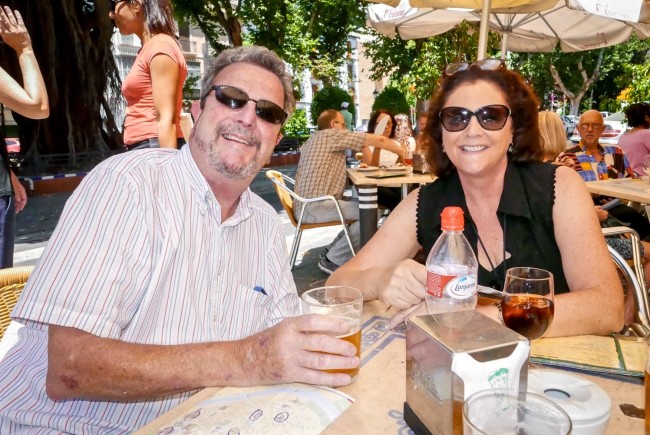 We headed back to the apartment, and I had thoughts of going out on my own to see one last sight in Sevilla. However, once I sat down, I knew I would not have enough energy to do the Macarena…well the Basilica de la Macarena (la Macarena is the patron saint of matadors…no bull). I had wanted to see the famed Nuestra Señora de la Esperanza (Virgin Of Hope), but at this moment I only hoped our legs could get us to dinner. Sevilla had been a busy few days of walking around.
We headed back to the apartment, and I had thoughts of going out on my own to see one last sight in Sevilla. However, once I sat down, I knew I would not have enough energy to do the Macarena…well the Basilica de la Macarena (la Macarena is the patron saint of matadors…no bull). I had wanted to see the famed Nuestra Señora de la Esperanza (Virgin Of Hope), but at this moment I only hoped our legs could get us to dinner. Sevilla had been a busy few days of walking around.
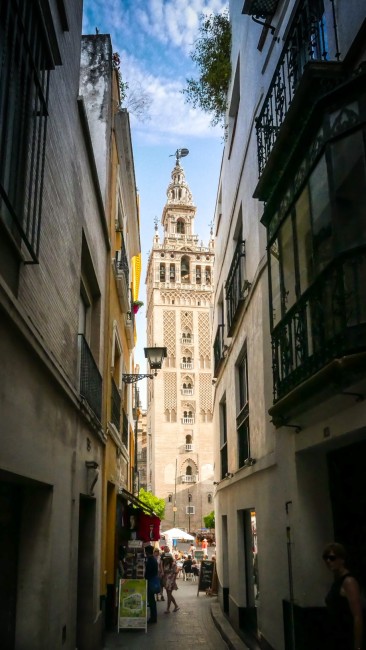 Fortunately, a couple of hours of down time rejuvenated the group, and we were back out on Sevilla’s streets heading toward dinner at Ristorante San Marco.
Fortunately, a couple of hours of down time rejuvenated the group, and we were back out on Sevilla’s streets heading toward dinner at Ristorante San Marco.
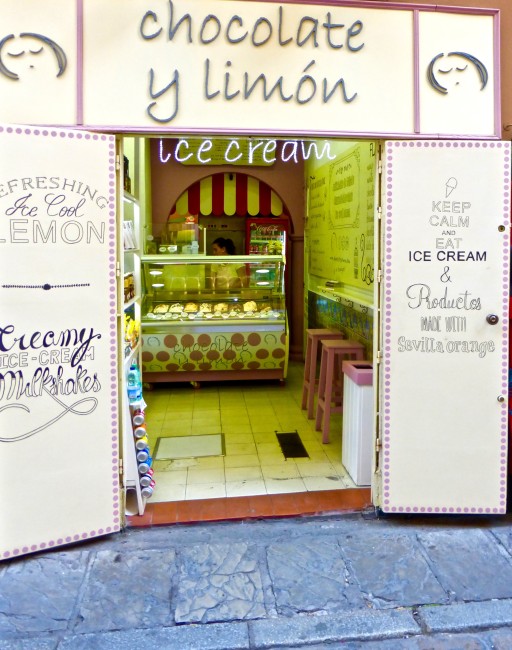 On our walk, we somehow passed up the ice cream, said hello to John Paul II…
On our walk, we somehow passed up the ice cream, said hello to John Paul II…
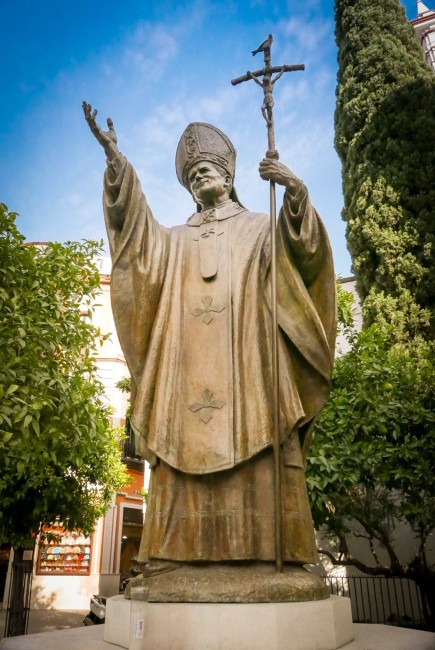 …and our wives even stopped in a little store for some last minute Sevilla shopping.
…and our wives even stopped in a little store for some last minute Sevilla shopping.
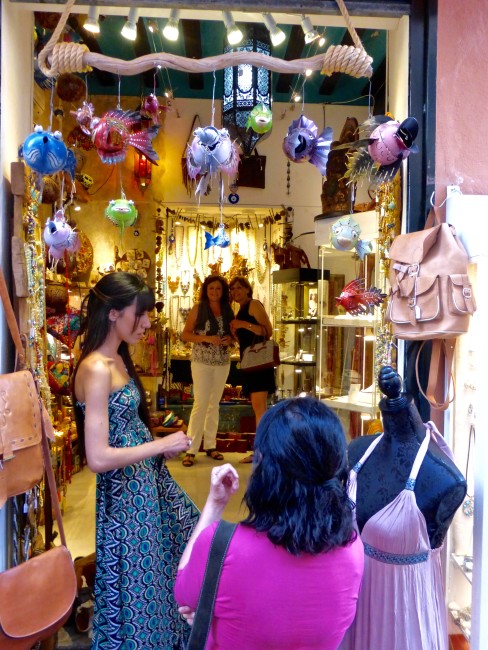 Arriving at 8 p.m. at Ristorante San Marco, Calle Meson del Moro, 6 in the el barrio de Santa Cruz, we were seated in the bath. That’s because this restaurant is located in a 12th-century Arab bath, one of only two Arab baths remaining in Sevilla.
Arriving at 8 p.m. at Ristorante San Marco, Calle Meson del Moro, 6 in the el barrio de Santa Cruz, we were seated in the bath. That’s because this restaurant is located in a 12th-century Arab bath, one of only two Arab baths remaining in Sevilla.
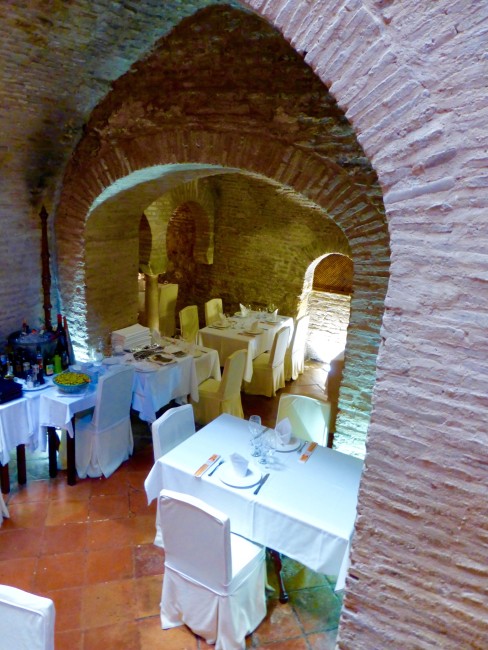 We were told that a lot of movie and music stars have dined here, including Madonna. So even though I had missed Nuestra Señora de la Esperanza at the Basilica de la Macarena, I told our group that should Madonna walk through the door, she’s “like a Virgin.” I know Kim immediately thought, “Thank God…only nine more nights.”
We were told that a lot of movie and music stars have dined here, including Madonna. So even though I had missed Nuestra Señora de la Esperanza at the Basilica de la Macarena, I told our group that should Madonna walk through the door, she’s “like a Virgin.” I know Kim immediately thought, “Thank God…only nine more nights.”
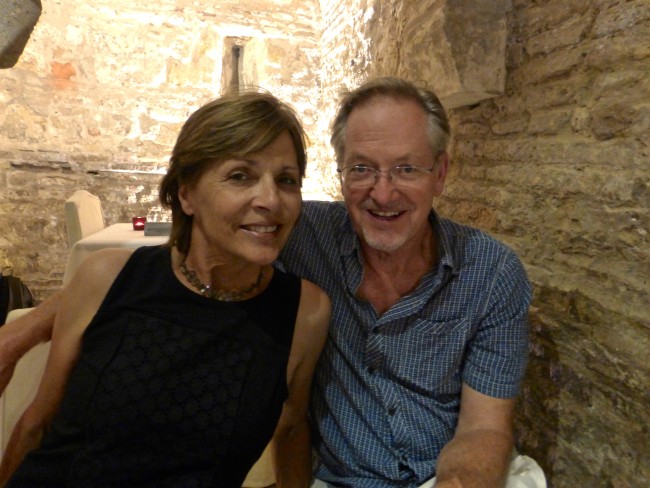 Tom Cruise has also been a guest at Ristorante San Marco, but I believed it would be risky business for another pun, which could render the rest of our travel mission…impossible.
Tom Cruise has also been a guest at Ristorante San Marco, but I believed it would be risky business for another pun, which could render the rest of our travel mission…impossible.
We had been looking forward to dining on the Italian/Mediterranean cuisine offered at Ristorante San Marco, and this place lived up to the billing.
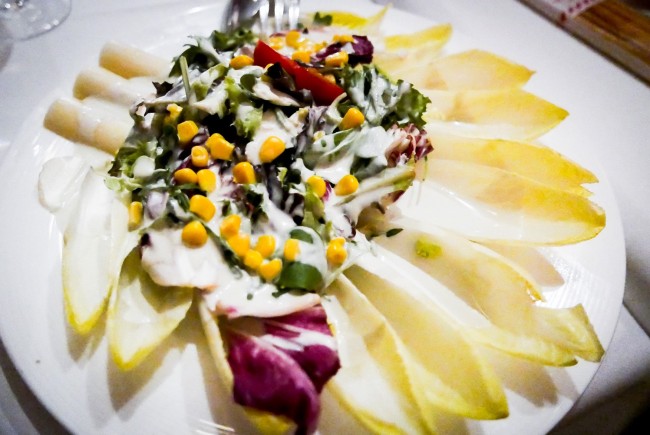 Mary and Kim shared a gigantic salad that looked like a satellite.
Mary and Kim shared a gigantic salad that looked like a satellite.
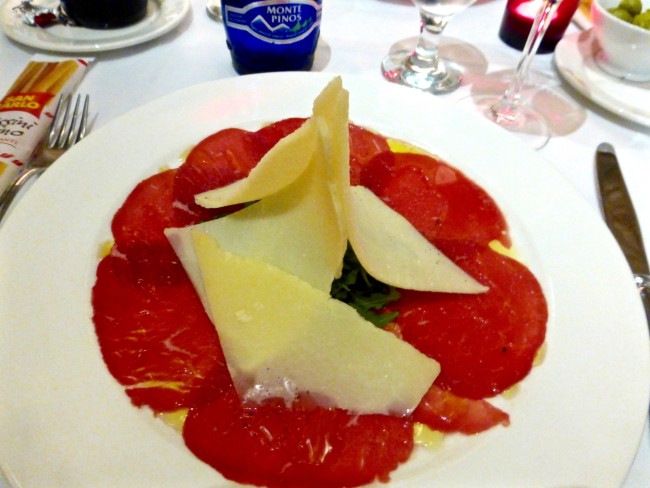 I loved my Harry’s Bar Carpaccio to start, followed by an Aglio y Olio and a stupendous crepe with ice cream and chocolate sauce for dessert.
I loved my Harry’s Bar Carpaccio to start, followed by an Aglio y Olio and a stupendous crepe with ice cream and chocolate sauce for dessert.
Total bill for dinner and two bottles of wine barely exceeded €100, probably less than half of what this meal would cost in Los Angeles.
We took a slow stroll back through Sevilla on this warm night. Three nights seemed like the right amount of time to spend here.
On our walk back, Tracy said, “You know, we didn’t go to any flamenco here.”
I answered, “Well, we still have three cities left for that.” The cathedral was lit up as we wandered back to the apartment.
Tomorrow, we’d catch an early train to Cordoba where we would spend one day and night. Once again a jaw-dropping architectural marvel would have us saying “Wow!” We’d also hang out for a while on some people’s patios (you’d think one person would offer me a GinTonic).
Next: Day Thirteen – The Train In Spain Is Really Not A Pain, Pillars Of Strength, Who Put This Cathedral In My Mosque, A Stable Environment, Flower Power, Pepe Power, My Biggest Fan, Hospital For The Water Fearers, A Quick Stop At Dominic, The Golden Arches, You’ll Fry On The Roof, A Familiar Wine, Bridge Work and Should We Hit Flamenco Tonight

